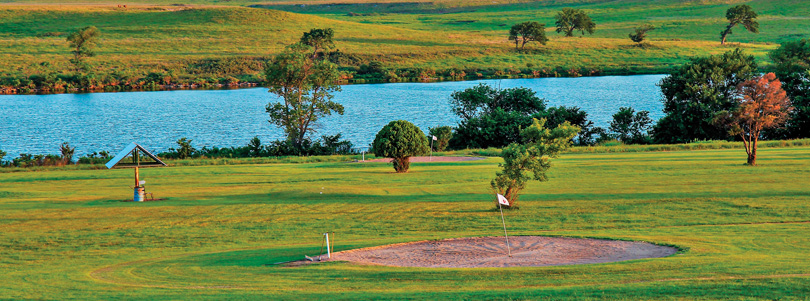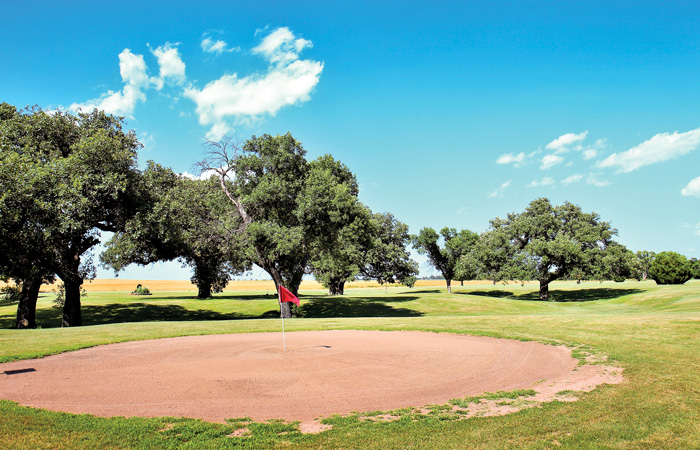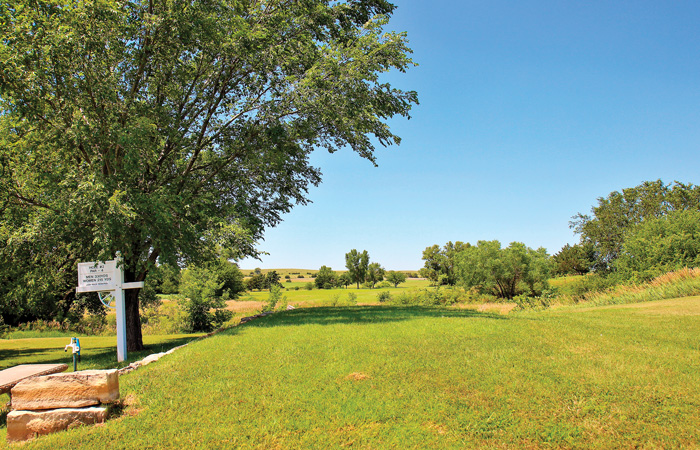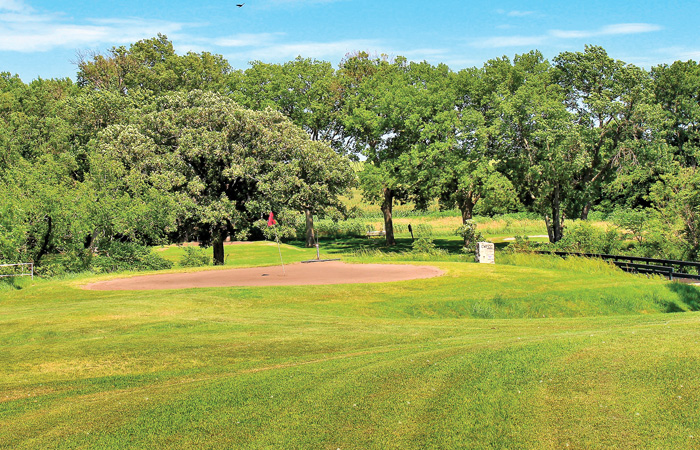Tales From the Back Nine Part VIII – Kansas

First time I ever saw Kansas, they were opening for Aerosmith at UTA’s Texas Hall. This is notable only because, about a century later, I actually toured the state of Kansas, and again Kansas was the backup band, stuck in my head the whole way.
Yep, a four-day road trip exploring wilderness golf adventures in the heartland. I drove all over the Jayhawk State searching for courses with sand greens. Saw paragliders hovering over the highway near Wichita. Visited the Bazaar Cemetery. Enjoyed epic sunsets and full moons by the campfire.
So many miles. So many twisting farm roads. So many silos. A geodesic dome. A snapping leather-back turtle. Charming nine-hole golf courses. And this, constantly in my head:
… Dust in the wind … all we are is …
Even the F-150, grizzled by 200,000 miles of age, got tired of hearing me thinking about the only lyrics I remember from that song. Every so often, he would make a strange sound as if a breakdown were imminent just to keep me focused on the task at hand, the steering wheel.
We were heading north on I-35 because I’ve long been fascinated by sand greens, and Kansas is pretty much the go-to sand-green destination spot. “Browns” hold an important place in golf history, having served as the original putting surface of many early American tracks.
Sand greens have been on golf’s endangered species list for decades. Seemingly built for the long haul, they were inexpensive to build and maintain, requiring no water and minimal conditioning. But in highly populated areas, sand greens mainly served as starter kits, ditched like orphans so their clubs could spend millions building fancy greens with dramatic undulations and then millions more on sophisticated turf and irrigation systems.
Most classic golf courses built before irrigation systems and sophisticated agronomy came into play started with sand greens. The Pinehurst Resort in North Carolina, a U.S. Open site, featured sand greens for almost 25 years before converting to grass in the 1930s. Three of Texas’ first four courses debuted with sand greens. Dallas Country Club was the lone exception with Bermuda greens. Galveston, San Antonio, Austin, and El Paso all opened with sandy putting surfaces.

In highly populated areas, virtually every course that opened with sand greens transitioned to 18-hole grass facilities. But sand greens held up in certain parts of the country, particularly in the Midwest and South, because their low cost allowed small towns to have a golf course. The genre is strongest in the Heartland _ Kansas, Nebraska, Colorado, and South Dakota. Texas, once a sand-green haven, is believed to have only one survivor, McLean Country Club, a pasture course in the Panhandle.
Kansas is pretty much the sand-green holy grail with maybe 20 courses (the USGA and the Kansas Golf Association do not designate courses by green types, thus no records). Kansas is the only state with a sanctioned sand division for high school competition with some 17 schools vying for the state title each May.
Sand-green courses do not have to deal with the issues that threaten modern facilities. The positive qualities of sand-green clubs _ $5 green fees for all day, fast pace of play, no irrigation or chemicals for maintaining tightly mowed grass, no dress codes, relaxed atmosphere _ would seem to paint a rosy picture for the future.
But let’s face it _ who wants to putt on sand? Many people have never heard of sand greens. Sure, serious players can have fun while testing his short game on these cozy tracks. And the beginner can develop in a casual non-intimidating setting where he can play quickly or all day for $5. But a movement is not afoot to embrace the old-fashioned concept as a mainstream golf alternative.
From the tee, most holes resemble any other course. But once you approach the “browns,” everything changes. The putting surfaces are small and flat, usually level with the ground. The greens have little variation in size and shape; they are all circular with the hole in the center.

Searching for sand greens is an adventure in and of itself. The old lug and I may as well have been picking antiques as we rolled along I-35 through Oklahoma. We hoped to make El Dorado State Park, 45 miles northeast of Wichita, by nightfall. From far North Dallas, Wichita is only a 5 ½ hour drive with no traffic.
But we were delayed 45 minutes by a traffic snarl in Denton and then who knows how long it took to get through the rush hour from hell in Oklahoma City. No way we were pitching tent in daylight.
Once we crossed the Kansas line, the landscape opened to expansive flatland views. The exits became few and far between. The drive was pleasant; not nearly as flat and boring as I feared, and it was a refreshing change from recent trips south on I-35 from Dallas. One nitpick, though, so take note, Kansas: The left-exit rest areas with McDonalds/gas station combos, which serve traffic from both directions, are just wrong.
True to our nature, we made too many stops to take too many snapshots of sad farms in slo-mo collapse mode, waiting in the middle of nowhere for their wayward owners, who left on horseback during a locust swarm in 1927, to return. By the time we noticed the paragliders soaring above the highway _ certainly a worthy photo-op _ we were too busy making up for lost time. Then, predictably, we stopped for supplies, and were left to view a bright orange sunset over Lake El Dorado at 75 mph. We pulled into the park just after 9 p.m. Having experienced overflow crowds at state parks around Austin last month, I was a bit spooked to find that we were virtually alone in Kansas’ largest state park.
The lake, swollen from recent rains, was about five feet over normal level. I got the fire going, pitched tent under the full moon, and then kicked back, enjoying the ice-cold watermelon lemonade my daughter made from scratch just before departure. I fell asleep looking at the moon and listening to fish splashing in the water, about 10 yards from the tent.
But when the sun came up, the white bass, walleye, wiper and catfish that call this lake home _ weren’t buying the plastic worms from Texas I was selling. So, off we went toward Downs Golf Club, our farthest point north.
Downs, population 850, sprung up from the prairie after the arrival of the Union Pacific in 1879. In the town’s heyday, 18 trains ran daily. Several freight trains still run through Downs. The town’s current claim to fame is hosting the Kansas Storytelling Festival. The golf club was founded in 1950 a few miles north of Main Street off SH 181. The place lists a P.O. Box and can be hard to find, so just take a right on 181 and look for the stone monument on the left, or just follow the large deer that greeted me and then roamed the fairways. The nine-hole course, measuring 2,700 yards, plays to a par of 35. The layout mimics the rolling prairies of the neighboring farmland. Downs has claimed five high school state sand-green titles.
Having never putted on sand, I hit my first putt at Downs from where my ball landed. Sand swallowed the putter head. The ball went maybe three feet.

The proper procedure, I later learned, is that once all balls are on the green, the player farthest from the hole smooths the surface with the “drag” device. This is the metal pole about the size of a golf club welded to a yard-wide lead pipe which flattens the surface. The groomer starts a yard past the hole and goes to the edge of the green then turns around and retraces the smoothed area to pack the sand grains toward the hole for smoother rolls. Each player then putts the distance his ball landed from the hole, and then someone rakes the footprints.
Once I figured this out, putting got easier. Still, even short putts required a pretty hefty backswing. Pitching to sand greens was a blast. With the sand providing a natural check, I fired the ball aggressively at the hole, sticking primarily with my 7-iron to launch foot-high pin-seekers.
We headed south on Hwy 181, a scenic tw0-lane drive on rolling terrain, for 18 miles to Tipton Oaks Golf Club. Tipton was originally called Pittsburg when founded in 1872. Then residents discovered that another Pittsburg existed in Kansas, so the name was changed to Tipton because, well, one resident used to live in Tipton, Iowa. Tipton, Kansas is virtually a blip on the map, weighing in with a population of 203. Somehow, the boys’ golf teams have captured eight state sand-green titles, tied with Mankato, 50 miles northeast, for the most.
Tipton Oaks was created in 1981 because a group of players grew tired of the 18-mile drive to Downs. According to the Wall Street Journal, they bought 42 acres of pastureland for $21,000 and then built the course with volunteer labor. An abandoned train depot was moved behind the first tee to serve as clubhouse. The layout, with a creek meandering throughout, has the look of a traditional tree-lined course but it measures just 2,466 yards (par-35). Like most of the courses in this area, Buffalo grass adorns the fairways because of its heat resilience. A membership of about 60 pays $75 dues per year. But Tipton’s population, like much of rural Kansas, is dwindling. Downtown looked mostly abandoned. One old storefront window still featured a bicentennial promotional painting.
The next morning, a left out of the park put us on the Flint Hills National Scenic Byway, which took us to Cottonwood Falls Golf Club. The two-lane road featured watercolor-like vistas of native grasses and wildflowers swaying in the tallgrass prairie. Back in the day, settlers followed the Santa Fe Trail through this area. Fortunately, some stopped to build towns such as Cottonwood Falls, population 874.
Justin Garr, longtime Cottonwood Falls member, was glad to see us although he certainly wasn’t expecting us. I told him I wanted to learn the art of sand-green putting and shoot some photos. He said, “Well, climb on in and I’ll take you on a tour. It’s a good thing you came today. With all this rain, the fairways are in great shape. We don’t have irrigation except for rain, so the fairways can start cracking in the summer.”
Cottonwood Falls, perched along the main road between two farms, is one of the area’s oldest courses, established in 1923. The right fairway on No. 2 has a tight out-of-bounds of barbed wire, tall shrubs, and trees. The next hole, a 100-yard downhill par-3, requires a shot through a chute of mature trees. The postage-stamp green offers long shots no margin for error. Step off the back of the green and you’ll roll down the creek bank. “See that fence post in the water?” Garr said, pointing at the shallows. “That’s a big snapping leatherback turtle. Don’t mess with him. Very fast.”
The quaint layout resembles the turtle’s back, with the first six holes encircling Nos. 7-8-9. About 122 members pay $40 per year. No tee times are required.
“We got a bunch of folks coming for a tournament, so I gotta practice,” Garr said, shaking my hand. “The clubhouse is air-conditioned. Cold beer’s only a buck in the vending machine. Make yourself at home.”
Having only one stop remaining near the Oklahoma border, we headed in the general direction of home. We hoped to reach Lakeview Golf Club in Shidler, OK., a 130-mile trek on lonely backroads, before sunset. With a couple of frigid soft drinks acquired for .50 from the Cottonwood Falls clubhouse, I got a gut bomb for the road and whiskey for the beast, who continued rolled merrily along _ at least at high speeds _ despite a sagging sway bar and faulty strut.
But we had gone three days without a serious miscommunication with Siri, so we were treading on borrowed time. The miles rolled on and yet our estimated arrival time kept getting later. Once we got off I-35 and onto the rural routes, Siri freaked out. I changed her voice to Brit accent just for grins but she was in no shape to drive. Turns out, we had lost service. We were off the grid, left to manually navigate the tricky zig-zags through sleepy farm towns and majestic fields. Each time the farm road ended at an intersection, I just kept hanging lefts and then the first right, and eventually found ourselves in Burden. Before I could apologize to a citizen for burdening them for directions, a policeman pulled up, so I laid my burden down: “I’m looking for Shidler, Oklahoma. Am I on the right track?” “Oh, yeah, but you still have about 50 miles to go,” he said. “Just go back the way you came and turn left at Highway 15.”
We were going about 70 when a bird came out of nowhere and hit the windshield with the thud of a hockey puck. I felt bad. The beast felt bad. But on we went. Finally, we crossed an old bridge to a dead end and saw the Lakeview Golf Club sign. The steep rocky road led us to massive field of waist-high prairie grass, which we weaved through for half a mile.
We arrived as the sun was setting. The vista from the hilltop clubhouse was remarkable, looking down on the wide-open linksy course. The rugged layout is nestled along Shidler Lake with the Osage Wind Farm as backdrop. The first hole goes downhill over dense rows of native grass. And the tall prairie grasses bordering the ninth hole glowed with a soft orange hue.
The clock may be ticking on sand greens. But dust in the wind? Not yet. Golf’s historical markers are just in survival mode, carrying on like wayward sons as usual.



